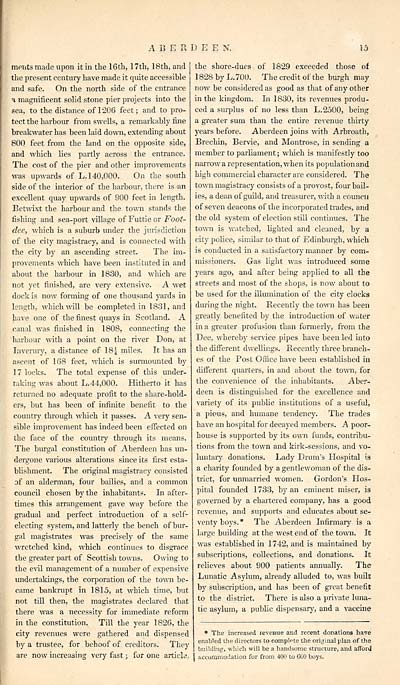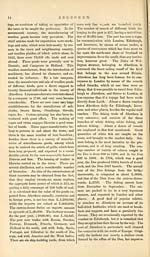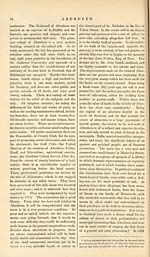Gazetteer of Scotland > Volume 1
(43) Page 15
Download files
Complete book:
Individual page:
Thumbnail gallery: Grid view | List view

A 13 E It D E E N.
\5
merits made upon it in the 16th, 17th, 18th, and
the present century have made it quite accessible
and safe. On the north side of the entrance
h magnificent solid stone pier projects into the
sea, to the distance of 1206 feet; and to pro-
tect the harbour from swells, a remarkably fine
breakwater has been laid down, extending about
800 feet from the land on the opposite side,
and which lies partly across the entrance.
The cost of the pier and other improvements
was upwards of L. 140,000. On the south
side of the interior of the harbour, there is an
excellent quay upwards of 900 feet in length.
Betwixt the harbour and the town stands the
fishing and sea-port village of Futtie or Foot-
dee, which is a suburb under the jurisdiction
of the city magistracy, and is connected with
the city by an ascending street. The im-
provements which have been instituted in and
about the harbour in 1830, and which are
not yet finished, are very extensive. A wet
dock is now forming of one thousand yards in
length, which will be completed in 1831, and
have one of the finest quays in Scotland. A
canal was finished in 1808, connecting the
harbour with a point on the river Don, at
Inverary, a distance of 18| miles. It has an
ascent of 168 feet, which is surmounted by
17 locks. The total expense of this under-
taking was about L. 44,000. Hitherto it has
returned no adequate profit to the share-hold-
ers, but has been of infinite benefit to the
country through which it passes. A very sen-
sible improvement has indeed been effected on
the face of the country through its means.
The burgal constitution of Aberdeen has un-
dergone various alterations since its first esta-
blishment. The original magistracy consisted
of an alderman, four bailies, and a common
coimcil chosen by the inhabitants. In after-
times this arrangement gave way before the
gradual and perfect introduction of a self-
electing system, and latterly the bench of bur-
gal magistrates was precisely of the same
wretched kind, which continues to disgrace
the greater part of Scottish towns. Owing to
the evil management of a number of expensive
undertakings, the corporation of the town be-
came bankrupt in 1815, at which time, but
not till then, the magistrates declared that
there was a necessity for immediate reform
in the constitution. Till the year 1826, the
city revenues were gathered and dispensed
by a trustee, for behoof of creditors. They
are now increasing very fast ; for one article.
the shore-dues of 1829 exceeded those of
1828 by L. 700. The credit of the burgh may
now be considered as good as that of any other
in the kingdom. In 1830, its revenues produ-
ced a surplus of no less than L.2500, being
a greater sum than the entire revenue thirty
years before. Aberdeen joins with Arbroath,
Brechin, Bervie, and Montrose, in sending a
member to parliament ; which is manifestly too
narrow a representation, when its population and
high commercial character are considered. The
town magistracy consists of a provost, four bail-
ies, a dean of guild, and treasurer, with a council
of seven deacons of the incorporated trades, and
the old system of election still continues. The
town is watched, lighted and cleaned, by a
city police, similar to that of Edinburgh, which
is conducted in a satisfactory manner by com-
missioners. Gas light was introduced some
years ago, and after being applied to all the
streets and most of the shops, is now about to
be used for the illumination of the city clocks
during the night. Recently the town has been
greatly benefited by the introduction of water
in a greater profusion than formerly, from the
Dee, whereby service pipes have been led into
the different dwellings. Recently three branch-
es of the Post Office have been established in
different quarters, in and about the town, for
the convenience of the inhabitants. Aber-
deen is distinguished for the excellence and
variety of its public institutions of a useful,
a pious, and humane tendency. The trades
have an hospital for decayed members. A poor-
house is supported by its own funds, contribu-
tions from the town and kirk-sessions, and vo-
luntary donations. Lady Drum's Hospital is
a charity founded by a gentlewoman of the dis-
trict, for unmarried women. Gordon's Hos-
pital founded 1 733, by an eminent miser, is
governed by a chartered company, has a good
revenue, and supports and educates about se-
venty boys.* The Aberdeen Infirmary is a
large building at the west end of the town. It
was established in 1742, and is maintained by
subscriptions, collections, and donations. It
relieves about 900 patients annually. The
Lunatic Asylum, already alluded to, was built
by subscription, and has been of great benefit
to the district. There is also a private luna-
tic asylum, a public dispensary, and a vaccine
* The increased revenue and recent donations have
enabled the directors to complete the original plan of the
building, which will be a handsome structure, and afford
accommodation for from 400 to COO boys.
\5
merits made upon it in the 16th, 17th, 18th, and
the present century have made it quite accessible
and safe. On the north side of the entrance
h magnificent solid stone pier projects into the
sea, to the distance of 1206 feet; and to pro-
tect the harbour from swells, a remarkably fine
breakwater has been laid down, extending about
800 feet from the land on the opposite side,
and which lies partly across the entrance.
The cost of the pier and other improvements
was upwards of L. 140,000. On the south
side of the interior of the harbour, there is an
excellent quay upwards of 900 feet in length.
Betwixt the harbour and the town stands the
fishing and sea-port village of Futtie or Foot-
dee, which is a suburb under the jurisdiction
of the city magistracy, and is connected with
the city by an ascending street. The im-
provements which have been instituted in and
about the harbour in 1830, and which are
not yet finished, are very extensive. A wet
dock is now forming of one thousand yards in
length, which will be completed in 1831, and
have one of the finest quays in Scotland. A
canal was finished in 1808, connecting the
harbour with a point on the river Don, at
Inverary, a distance of 18| miles. It has an
ascent of 168 feet, which is surmounted by
17 locks. The total expense of this under-
taking was about L. 44,000. Hitherto it has
returned no adequate profit to the share-hold-
ers, but has been of infinite benefit to the
country through which it passes. A very sen-
sible improvement has indeed been effected on
the face of the country through its means.
The burgal constitution of Aberdeen has un-
dergone various alterations since its first esta-
blishment. The original magistracy consisted
of an alderman, four bailies, and a common
coimcil chosen by the inhabitants. In after-
times this arrangement gave way before the
gradual and perfect introduction of a self-
electing system, and latterly the bench of bur-
gal magistrates was precisely of the same
wretched kind, which continues to disgrace
the greater part of Scottish towns. Owing to
the evil management of a number of expensive
undertakings, the corporation of the town be-
came bankrupt in 1815, at which time, but
not till then, the magistrates declared that
there was a necessity for immediate reform
in the constitution. Till the year 1826, the
city revenues were gathered and dispensed
by a trustee, for behoof of creditors. They
are now increasing very fast ; for one article.
the shore-dues of 1829 exceeded those of
1828 by L. 700. The credit of the burgh may
now be considered as good as that of any other
in the kingdom. In 1830, its revenues produ-
ced a surplus of no less than L.2500, being
a greater sum than the entire revenue thirty
years before. Aberdeen joins with Arbroath,
Brechin, Bervie, and Montrose, in sending a
member to parliament ; which is manifestly too
narrow a representation, when its population and
high commercial character are considered. The
town magistracy consists of a provost, four bail-
ies, a dean of guild, and treasurer, with a council
of seven deacons of the incorporated trades, and
the old system of election still continues. The
town is watched, lighted and cleaned, by a
city police, similar to that of Edinburgh, which
is conducted in a satisfactory manner by com-
missioners. Gas light was introduced some
years ago, and after being applied to all the
streets and most of the shops, is now about to
be used for the illumination of the city clocks
during the night. Recently the town has been
greatly benefited by the introduction of water
in a greater profusion than formerly, from the
Dee, whereby service pipes have been led into
the different dwellings. Recently three branch-
es of the Post Office have been established in
different quarters, in and about the town, for
the convenience of the inhabitants. Aber-
deen is distinguished for the excellence and
variety of its public institutions of a useful,
a pious, and humane tendency. The trades
have an hospital for decayed members. A poor-
house is supported by its own funds, contribu-
tions from the town and kirk-sessions, and vo-
luntary donations. Lady Drum's Hospital is
a charity founded by a gentlewoman of the dis-
trict, for unmarried women. Gordon's Hos-
pital founded 1 733, by an eminent miser, is
governed by a chartered company, has a good
revenue, and supports and educates about se-
venty boys.* The Aberdeen Infirmary is a
large building at the west end of the town. It
was established in 1742, and is maintained by
subscriptions, collections, and donations. It
relieves about 900 patients annually. The
Lunatic Asylum, already alluded to, was built
by subscription, and has been of great benefit
to the district. There is also a private luna-
tic asylum, a public dispensary, and a vaccine
* The increased revenue and recent donations have
enabled the directors to complete the original plan of the
building, which will be a handsome structure, and afford
accommodation for from 400 to COO boys.
Set display mode to: Large image | Transcription
Images and transcriptions on this page, including medium image downloads, may be used under the Creative Commons Attribution 4.0 International Licence unless otherwise stated. ![]()
| Gazetteers of Scotland, 1803-1901 > Gazetteer of Scotland > Volume 1 > (43) Page 15 |
|---|
| Permanent URL | https://digital.nls.uk/97424878 |
|---|
| Description | Volume I: Abbey to Glenartney. |
|---|---|
| Attribution and copyright: |
|
| Description | By Robert Chambers and William Chambers. Glasgow: Blackie & Son, 1838. 2 volumes. |
|---|---|
| Shelfmark | NF.1461.g.7 |
| Additional NLS resources: | |

